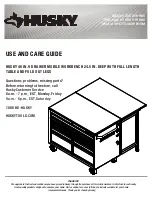
W632GG6KB
Publication Release Date: Jan. 03, 2017
Revision: A06
- 65 -
8.15 Refresh Command
The Refresh command (REF) is used during normal operation of the DDR3 SDRAMs. This command
is non persistent, so it must be issued each time a refresh is required. The DDR3 SDRAM requires
Refresh cycles at an average periodic interval of t
REFI
. When CS#, RAS# and CAS# are held Low and
WE# High at the rising edge of the clock, the chip enters a Refresh cycle. All banks of the SDRAM
must be precharged and idle for a minimum of the precharge time t
RP
(min) before the Refresh
Command can be applied. The refresh addressing is generated by the internal refresh controller. This
makes the address bits
“Don't Care” during a Refresh command. An internal address counter supplies
the addresses during the refresh cycle. No control of the external address bus is required once this
cycle has started. When the refresh cycle has completed, all banks of the SDRAM will be in the
precharged (idle) state. A delay between the Refresh Command and the next valid command, except
NOP or DES, must be greater than or equal to the minimum Refresh cycle time t
RFC
(min) as shown in
Figure 55. Note that the t
RFC
timing parameter depends on memory density.
In general, a Refresh command needs to be issued to the DDR3 SDRAM regularly every t
REFI
interval.
To allow for improved efficiency in scheduling and switching between tasks, some flexibility in the
absolute refresh interval is provided. A maximum of 8 Refresh commands can be postponed during
operation of the DDR3 SDRAM, meaning that at no point in time more than a total of 8 Refresh
commands are allowed to be postponed. In case that 8 Refresh commands are postponed in a row,
the resulting maximum interval between the surrounding Refresh commands is limited to 9 × t
REFI
(see Figure 56). A maximum
of 8 additional Refresh commands can be issued in advance (“pulled in”),
with each one reducing the number of regular Refresh commands required later by one. Note that
pulling in more than 8 Refresh commands in advance does not further reduce the number of regular
Refresh commands required later, so that the resulting maximum interval between two surrounding
Refresh commands is limited to 9 × t
REFI
(see Figure 57). At any given time, a maximum of 16 REF
commands can be issued within 2 x t
REFI
. Self-Refresh Mode may be entered with a maximum of
eight Refresh commands being postponed. After exiting Self-Refresh Mode with one or more Refresh
commands postponed, additional Refresh commands may be postponed to the extent that the total
number of postponed Refresh commands (before and after the Self-Refresh) will never exceed eight.
During Self-Refresh Mode, the number of postponed or pulled-in REF commands does not change.
TIME BREAK
DON'T CARE
DRAM must be idle
DRAM must be idle
NOTES:
1. Only NOP/DES commands allowed after Refresh command registered until t
RFC
(min) expires.
2. Time interval between two Refresh commands may be extended to a maximum of 9 x t
REFI
.
T0
T1
Ta0
Ta1
Tb0
Tb1
Tb2
Tb3
CK#
Command
REF
NOP
NOP
REF
NOP
VALID
NOP
Tc1
Tc0
Tc2
Tc3
NOP
t
RFC
VALID
REF
VALID
VALID
VALID
VALID
VALID
VALID
t
RFC
(min)
t
REFI
(max. 9 x t
REFI
)
CK
Figure 55
– Refresh Command Timing
















































